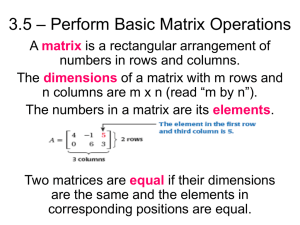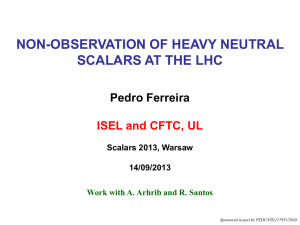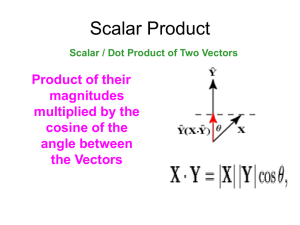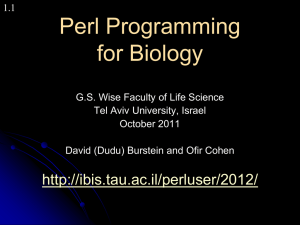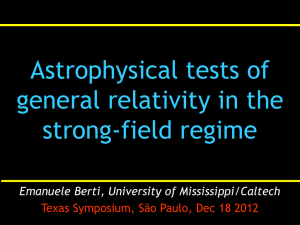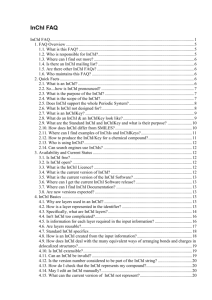A global resource for computational chemistry
advertisement
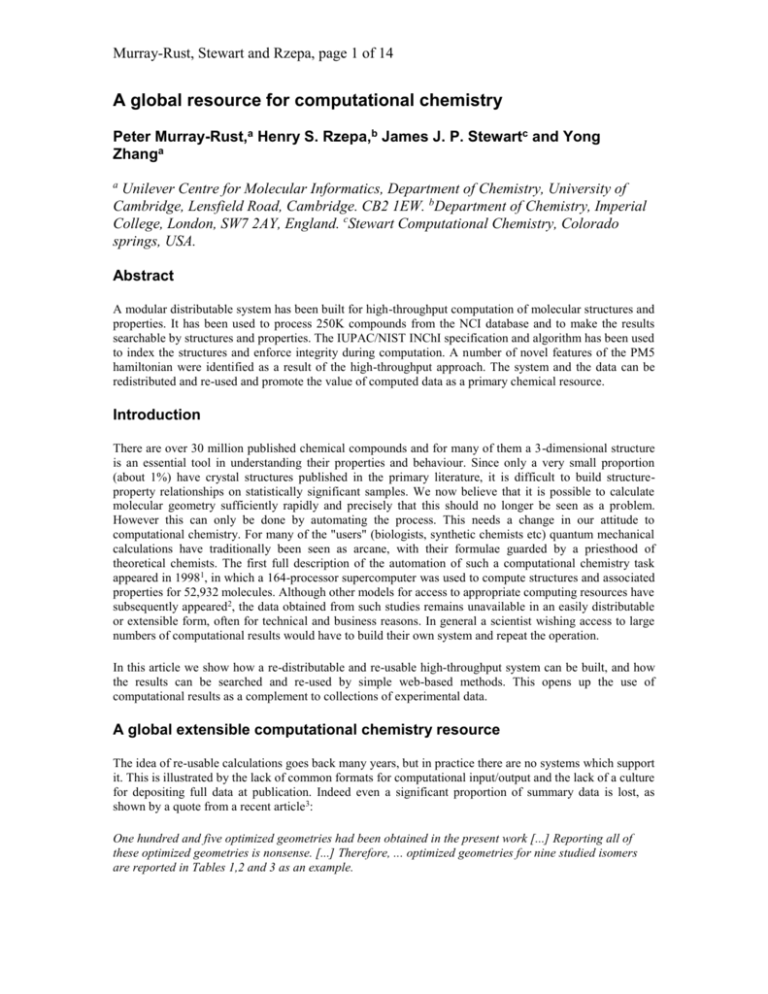
Murray-Rust, Stewart and Rzepa, page 1 of 14 A global resource for computational chemistry Peter Murray-Rust,a Henry S. Rzepa,b James J. P. Stewartc and Yong Zhanga a Unilever Centre for Molecular Informatics, Department of Chemistry, University of Cambridge, Lensfield Road, Cambridge. CB2 1EW. bDepartment of Chemistry, Imperial College, London, SW7 2AY, England. cStewart Computational Chemistry, Colorado springs, USA. Abstract A modular distributable system has been built for high-throughput computation of molecular structures and properties. It has been used to process 250K compounds from the NCI database and to make the results searchable by structures and properties. The IUPAC/NIST INChI specification and algorithm has been used to index the structures and enforce integrity during computation. A number of novel features of the PM5 hamiltonian were identified as a result of the high-throughput approach. The system and the data can be redistributed and re-used and promote the value of computed data as a primary chemical resource. Introduction There are over 30 million published chemical compounds and for many of them a 3-dimensional structure is an essential tool in understanding their properties and behaviour. Since only a very small proportion (about 1%) have crystal structures published in the primary literature, it is difficult to build structureproperty relationships on statistically significant samples. We now believe that it is possible to calculate molecular geometry sufficiently rapidly and precisely that this should no longer be seen as a problem. However this can only be done by automating the process. This needs a change in our attitude to computational chemistry. For many of the "users" (biologists, synthetic chemists etc) quantum mechanical calculations have traditionally been seen as arcane, with their formulae guarded by a priesthood of theoretical chemists. The first full description of the automation of such a computational chemistry task appeared in 19981, in which a 164-processor supercomputer was used to compute structures and associated properties for 52,932 molecules. Although other models for access to appropriate computing resources have subsequently appeared2, the data obtained from such studies remains unavailable in an easily distributable or extensible form, often for technical and business reasons. In general a scientist wishing access to large numbers of computational results would have to build their own system and repeat the operation. In this article we show how a re-distributable and re-usable high-throughput system can be built, and how the results can be searched and re-used by simple web-based methods. This opens up the use of computational results as a complement to collections of experimental data. A global extensible computational chemistry resource The idea of re-usable calculations goes back many years, but in practice there are no systems which support it. This is illustrated by the lack of common formats for computational input/output and the lack of a culture for depositing full data at publication. Indeed even a significant proportion of summary data is lost, as shown by a quote from a recent article3: One hundred and five optimized geometries had been obtained in the present work [...] Reporting all of these optimized geometries is nonsense. [...] Therefore, ... optimized geometries for nine studied isomers are reported in Tables 1,2 and 3 as an example. Murray-Rust, Stewart and Rzepa, page 2 of 14 Such selective tabulation of results is not atypical, and it is worth considering what this tells us about the publication process. Most journals (including the one where the above was published) have had supporting or supplemental information schemes for some time. The following extracts from author submission guidelines for such material are representative: Supporting Information should be formatted to fit within a minimum number of pages, e.g., text and tabular material should be double spaced and graphics should be reduced to a size that still allows clear viewing over the Web ... The page size should be (U.S. Letter) ... All pages should be numbered consecutively starting with page S1... All Supporting Information files of the same type should be submitted as a single file (rather than submitting a series of files containing individual images or structures). Where appropriate, supporting information should be consolidated into a single word-processing file... The emphasis on the "printable page" as a unit of information in these instructions often takes precedence over facilitating or encouraging re-use of the data in a computer-readable or semantic sense, and hence can result in the loss of data as illustrated above. In this study the results are envisaged as being re-usable in several ways: A chemist can submit new molecules to a web-server which will optimise their structures and compute properties. The results are then added to the archive in an institutional repository. This is the chemical equivalent of peer2peer sharing, where it is possible to offer e.g. semi-empirical quantum mechanical calculations by "payment" through the exchange of complementary information. The concept involves the user submitting a molecule and its 3D coordinates along with, say, its melting point and optical rotation as a "payment" and receiving computational results in return. These data are then integrated with the submitted information and made openly available to the global community. Anyone with molecular information would be encouraged to use this service and thereby to add to the communality of resources. In this spirit all our software (but not third-party) is OpenSource. The computational methods in the system can be replaced so that different methodologies can be used for existing compounds. The results can be re-used independently of the original motivation for calculation; for example o as starting points for further theoretical chemical calculations o as building blocks for geometry of complex molecules, and e.g. extraction of pharmacophores o large classes of closely related compounds can be used to give systematics about the effects of substitution on geometry and charge distributions. o The outliers in the distribution (geometry, charges, properties) can be identified and manually examined. These can give new chemical insights and suggest new systems for systematic study. o the creation of a library of fragments. o the systematic examination of a large and consistent collection of chemical computation for trends in convergence, pathological behaviour, etc. Such computations, carried out by an exposed protocol and with universal metadata, are by themselves reusable objects of value to the community. A collection of such objects should be regarded in the same way as a database of experimental data. The protocol itself leads directly to improvements in the methodology in (at least) QM calculations. Variation from experimental data or internal variance may suggest places where the methodology can be refined. Creation of an RSS-based "news feed"4 as the calculations are archived Web-search for individual archived calculations, including chemical structure, followed if desired by download of appropriate components of the archived calculations The infrastructure itself can be replicated and used at difference sites or for a different sets of molecules. Merging, sorting and re-use of the separate databases is facilitated. Murray-Rust, Stewart and Rzepa, page 3 of 14 Unlike previous studies, this work was carried out on "free" computers without requiring bespoke software. It used 20 teaching machines during a vacation and a system that can be easily replicated and copied. Relatively few copies of the system would be able to calculate most of the published 10-15 million molecules and would still represent a trivial fraction of the global chemical computational resource. 2 Methodology for High Throughput MOPAC Calculation What follows describes the creation of a resource based on 0.25 million molecules5 with initial 3D structures optimised using the PM5 semi-empirical method.6 A key strategy is that the same methodology (protocol) was applied to each molecule. The results of this are publicly available in XML format. 7 The molecule input set The collection of compounds as assembled by the US National Cancer Institute (NCI) over a 30 year period of screening was chosen. This dataset is in the public domain and is widely used in molecular modelling. 5 One motivation of the current work was to repay this public effort by enhancing it with additional calculated properties. The NCI entries had a wide chemical range, although there was no initial documentation of the type and frequency of different molecular classes. It was decided that at the outset, all molecules would be submitted to the calculation and then the data set would be filtered and the protocol adjusted accordingly. Each compound has a unique identifier (NCI or NSC number), a 2D connection table (structural diagram) and a set of 3D coordinates. These coordinates represent a conformer (not necessarily either a low energy or a global minimum) generated by the Corina program. 8 The 2D and 3D files were distinct and, as discovered in retrospect, do not always correspond precisely. In particular for ionic salts the 3D structure contained only one ion, usually the largest. The creation of a searchable database has been made possible through the recent development of unique chemical identifiers in the IUPAC/NIST task force (INChI). 9 This is provided by an algorithm which normalises the description of the connectivity of a molecule, and creates a canonical representation. Because the INChI approach is independent of formal bond order and depends only on the nature and connectivity of atoms it is ideally suited to the representation of this type of computational study. Every molecule, therefore, generates a characteristic INChI and this can be used not only to index them but to determine whether two connection tables are different. It is important to note that the INChI is computed only from the molecular structure and is not absolutely bound to names or organisational identifiers. Thus the structure CH3C(=NOH)C(=NOH)CH3 is associated with the name "NSC9", and many names such as "Biacetyl, dioxime" and "Dimethylglyoxime". If later a structure for NSC9 is found to be wrong (i.e. NSC9 does not correspond to CH3C(=NOH)C(=NOH)CH3), the association is removed. Our indexing depends on the molecular structure and its connection table rather than being based on NSC numbers or names. In this way all of the current work would still be valid even if NSC numbers were revised or withdrawn. Importantly it acts as a globally agreed identifier with a similar function to the recently proposed Life sciences identifier (LSID).10 Because the NCI data set has been built over many years the quality varies considerably 11. This does not affect the current work since the only information used is the 3D coordinates and the unique identifier generated from them. We attach the NCI number but stress that it only corresponds to the assignment current in NCI in 2003 CE. If readers wish to link into samples or screening data they should consult NCI records. If these caveats are carefully observed, however, readers and re-users should be able to use our calculated properties to add to any studies done with the NCI data set. Methodology Murray-Rust, Stewart and Rzepa, page 4 of 14 The developmental history is described in some detail, since the architecture was continually redefined whenever understanding was improved or new technology introduced. Some of the initial design caused considerable problems later, and involved more human effort than had been planned. Our final architecture requires much less human effort, but nonetheless this is still more important than the computer resources. The ultimate objective is to develop a system where no human curation is required. The basic strategy was to find a single protocol that could be applied automatically to all molecules. Although this study used only one code, MOPAC2002, the architecture is designed to be generic and can be used with any computational code (whether based on quantum mechanical or molecular mechanical theories) that accepts coordinates and control parameters. It is based on single units of calculation or jobs (Figure 1). A job is the minimum unit for which there are logical inputs or outputs (in XML), and could be based on calculations using more than one physical job linked by legacy workflow. In this study an initial decision was taken to define a single physical MOPAC job as comprising 500 independent logical jobs to minimise operational overheads. We emphasize that this leads to new approaches to developing systems where the final approach may be considerably different from the beginning. Fig 1. A single logical MOPAC job Although MOPAC2002 uses a single physical ASCII input stream this is abstracted into two logical streams serialized as XML: the input coordinates (including elementTypes and total charge). the control parameters ("the protocol") defining the method, limit of convergence, etc. In principle the control parameters might depend on the nature of the molecule but throughout this work they were constant for each MOPAC unit. The logical streams are combined through the use of transformations based on XSLT (extensible stylesheet language)12 to create the flat MOPAC input. MOPAC2002 results can occur on several streams but in this work only the single logfile, containing the complete history of the calculation, has been used. This output contains the initial configuration, optimisation history, and final coordinates with properties (wavefunction, normal modes, charges, etc.) computed at this geometry. From this physical stream, two or more logical streams are extracted as XML. Our architecture allows jobs to be linked into a workflow under the control of a script (such as ant) or workflow engine and an example is shown in logical form (Fig. 2): Murray-Rust, Stewart and Rzepa, page 5 of 14 Fig 2. workflow for MOPAC jobs Here job1 uses the raw coordinates and the initial protocol params1 to produce an output. If successful this is parsed into XML (see below), combined with params2 and passed into job2 which is similarly chained into job3. Error Handling It became clear that even 0.01% error rate could not be tolerated so methods had to anticipate all kinds of failure. Any unexpected program exits are detected and the workflow is aborted. There are many reasons for such errors. the physical job overran time limits. an abnormal input structure was detected (including physically unrealistic molecular geometries with close approach of two or more atoms). there were difficulties in convergence or other pathological behaviour. the program crashed. In fact this happened only very rarely (less than 5 times in 750000 MOPAC jobs) the system crashed. Also very infrequent, causes being machines switched off, worm attack, etc. Murray-Rust, Stewart and Rzepa, page 6 of 14 Evolution of the protocols The initial strategy was to use a single protocol to optimize all 250K molecules using loose convergence criteria (internal rather than cartesian coordinates and relatively high final coordinate gradients). This allowed rapid feedback about the nature of the data, the times for computation, the pathology, etc, from which was discovered that; about 1% of the molecules were immediately rejected by MOPAC. This was usually due to unusual elements for which PM5 parameters were not available, grossly unreasonable connection tables (e.g. some molecules were decorated with superfluous hydrogen atoms) or errors resulting from unacceptably close contacts between two atoms. The times varied from 0.5 - 500,000 seconds per molecule, a factor of 10**6. This had an immediate consequence for later jobs. Manual inspection of molecules with large computation times revealed them to be invariably large and many such as oligopeptides were conformational highly flexible. It is not clear that automatic calculation for such molecules is useful and in later stages they were crudely filtered by runtime limits. Certain molecules converged very slowly. In general these again were flexible or had very flat minima. These problems were addressed in later jobs by recalculating the Hessian (second derivative matrix) every 25 or less cycles to provide better search directions for the geometry optimiser. Initially the jobs were set up manually and to save time 500 physical MOPAC jobs, each containing 500 molecules, were created and a Condor batch system was installed for managing the submission of jobs to PCs as they became free. The batch system was used to avoid latency in starting jobs. The NSC number was not initially contained in the MOPAC job and this caused problems when sub-jobs terminated abnormally. Without the NSC number considerable effort was required to link the output results to the appropriate input. Moreover it was assumed that each batch would run for approximately similar times, but in reality, some batches contained many "expensive" molecules and this disrupted the workflow. Experiments established that the optimum number of molecules submitted per batch jobs should be reduced to 10-50 to lessen problems with error tracking. The Condor system ran virtually without problems and reduced the human time considerably. With a relatively low time to completion for batches of 10-50 molecules, there was no need to invoke more complex aspects of the operation of Condor such as job checkpointing and restarting. Late in the project, a Xindice database13 was incorporated into the protocol. This is a native XML database, i.e. one to which an XML document can be directly added without needing a database schema. Any element in the document can be indexed. In this work documents were indexed through the INChI identifier. The process of obtaining this identifier includes normalization of the structure (e.g. aromaticity, bond order, stereochemistry, etc.), canonicalization and serialization to a unique string. Thus NSC1, methyl benzoquinone (Figure 3) has a basic INChI of C7H6O2,1H3-5-4H-6(8)2H-3H-7(5)9. INChI can also be used to add canonicalization for charge, tautomers, stereochemistry and isotopes. Figure 3. Carbon framework for methyl benzoquinone. Murray-Rust, Stewart and Rzepa, page 7 of 14 The complete XML output of the final jobs was loaded into Xindice 13 and made searchable via the INChI identifier. It is stressed that this identifier is a precise uniquifier for the molecule regardless of its likely stability or reasonableness. During loading into Xindice, it was discovered that there was much molecule duplication within the database and this was later confirmed in discussions with NCI. It arises from historical problems in checking manual data entry, but most importantly from the way that the 3D structures were generated. Many NCI compounds had two or more molecules as in salts and complexes. The 3D structures retained only the largest entity such as an organic cation or host. Moreover many of the 2D INChIs were different from the 3D INChIs, suggesting problems in the generation of structures. In many cases this is due to ambiguity in the number of hydrogen atoms; in general any entries of this form were discarded. Because of the very large number of structures and their chemical variety, a number of rare problems were encountered. This effectively stress-tested MOPAC and several minor bugs and features is this code were addressed as part of the workflow. We believe such an approach to architecture and dataset design could be a useful tool for testing other codes. During the process of refining the protocol, it became clear that the first phase had an unacceptably high convergence limit for geometry optimisation, so stricter values were only progressively introduced. Fortunately the Condor system was able to "scavenge" more computing cycles than originally envisaged, and the normal levels of precision for single-molecule optimization were ultimately adopted for all the calculations. An important component of the initial protocol was to include mandatory calculation of the Hessian matrix (the matrix of second derivatives of energy with respect to atom coordinates). Many years of experience have suggested that accidental (or imposed) initial coordinate symmetry may result in unwarranted conclusions regarding the final molecular geometry or symmetry. After the final phase it was noticed that a significant proportion of molecules had one or more negative eigenvalues computed for this Hessian matrix, indicating that the molecule was not at an energy minimum but on a higher order stationary point such as a transition state. A solution to this is to use the "eigenvector following" (EF) algorithm to follow the vectors corresponding to the negative eigenvalues. This should result (in theory) in coordinates corresponding to lower molecular energies devoid of any negative Hessian eigenvalues. Typically, such modes arise from eclipsed methyl or alkyl groups, or from planar starting geometries for intrinsically nonplanar groups such as aromatic amines, amides, etc. In practice, although eigenvector following removes a certain proportion of these negative roots, some remain in the final output (due possibly to round-off error in derivative calculation, possibly even a small degree of rotational variance of the wavefunction itself, or unidentified errors in the EF algorithm). XML makes it easy to identify them so that they could be passed to other codes for further analysis. Analysis of the MOPAC Calculations The very large number and variety of the molecules puts an unusual stress on any program used and is thus well suited to the detection of systematic features and rare problems. For example one error occurred only once per 64K calculations, and the process discovered more "bugs" (albeit minor) than had been reported by the general user community. The high throughput of molecular geometry optimisation sustainable for the NCI database allows some general conclusions to be drawn for the benefits and value of this procedure. For each molecule, a direct comparison can be made of the INChI identifier computed before and after optimisation. This process highlights differences in the molecular connection table resulting from the MOPAC optimisation, something that is inherently possible in a quantum mechanical approach in which bonds are defined from electron densities rather than arbitrarily defined connectivity. We note for example that this differs from a geometry optimisation based on molecular mechanics force fields, from which the initially defined Murray-Rust, Stewart and Rzepa, page 8 of 14 connectivity will always be maintained. The approximately 1500 molecules for which the INChI identifier was detected to differ clustered into the following types (see supporting information). 1. 2. 3. 4. 5. 6. Molecules containing a metal atom (Pb, Sn, Ge, Bi, Sb, As, Te, Se) where an increase in coordination is observed. These may be either representational differences or real errors in the MOPAC calculations. Molecules which split into separate fragments (for which an INChI identifier is separately computed) resulting from the cleavage of one or more bonds Molecules for which the starting structure was wrong/impossible. They include highly bonded atoms, missing charges or missing hydrogens from the original specification. It is worth noting that MOPAC applies no initial checksum for molecule integrity, such as consistency between declared spin state (singlet, doublet, triplet) and the inferred electron count. Providing information about the spin state would probably allow detection of a significant proportion of such errors, but since this information is rarely declared explicitly it would also require heuristics to allow its automated inference. Molecules where the input specification was clearly in error. Whilst it is impossible to know what the original authors meant, MOPAC has produced an entirely reasonable final geometry. Examples are interpenetrating groups, C-O-O rings instead of esters, etc. Molecules for which the input is reasonable and so is the result but they are different. Examples include tautomers, internal H-bonding connectivity and changes in coordination of the central atom, particularly of electron deficient atoms such as boron, where the conventional structural representation may in fact differ significantly from the more correct quantum mechanical solution. Molecules for which the input is reasonable, but for which the output is not. These examples cluster around elements such as S (and S=O), Iodine and Cl=O systems, and may be clearly revealing significant errors in the MOPAC PM5 parametrisations 6 (or basis set) for these specific elements Details of the architecture: Physical Job input Data defining a calculation are supplied to MOPAC as a text input file, an example of which is shown below. T=3600 RECALC=8 PRECISE GNORM=0.1 PM5 charge=0 [id=NSC1][pos=1][name=mol1]Use XYZ by default O 0.000290244 1 -0.000903121 1 -0.015300924 1 O 5.347499281 1 0.000311673 1 -0.007858664 1 C 1.213650143 1 0.012635295 1 0.006474477 1 C 2.009053248 1 0.075474328 1 1.273690672 1 C 2.011209564 1 -0.032244702 1 -1.248537182 1 C 3.342679361 1 0.076581872 1 1.246036378 1 C 3.334957003 1 -0.031045737 1 -1.257001854 1 C 4.132927668 1 0.014234366 1 -0.003133918 1 C 1.272277641 1 0.135551552 1 2.564964014 1 H 1.436535185 1 -0.067928597 1 -2.187213675 1 H 3.923094550 1 0.124051171 1 2.181187589 1 H 3.900632171 1 -0.064767851 1 -2.200725717 1 H 0.175274725 1 0.126954174 1 2.446373770 1 H 1.544866796 1 -0.729230798 1 3.197213850 1 H 1.540265631 1 1.057706864 1 3.112371660 1 PM5 OLDGEO FORCE THERMO(298) [id=NSC1] The first line consists of keywords, of which there are six in the example shown, four of which have assigned (non-default) values. and which control the calculation. The next two lines are user comments or titles, which may include the name of the molecule and the purpose of the calculation. The next set of lines defines the geometry. Because the NCI molecules are held in the SDF format a conversion process is necessary. We use a two stage process in which the SDF files are first converted into CML files using the JUMBO toolkit. A stylesheet (cml2mopac.xsl) is used in the second stage to convert the molecule from CML into the native MOPAC input (*.mop file) by combining with Job Controls and Algorithm template and Dictionary. This structure allows different types of job to be defined using the appropriate Job Controls Murray-Rust, Stewart and Rzepa, page 9 of 14 and Algorithm template (Figure 4). The job controls used in our calculation are time limitation, specifying how often the Hessian second derivative matrix is recalculated and a normal coordinate analysis following completion of geometry optimisation. These are specified as CMLComp: 14 <parameterList role="ccml:control"> <parameter> <scalar dictRef="mopac:timesec">3600</scalar> </parameter> <parameter> <scalar dictRef="mopac:recalc">true</scalar> </parameter> <parameter> <scalar dictRef="mopac:force">true</scalar> </parameter> </parameterList> Figure 4. Workflow schematic for conversion of an SDF file to a Mopac input file. Physical Job output and CMLComp Part of a Mopac output stream is shown below; ******************************************************************************* ** MOPAC2002 (c) Fujitsu ** PM5 CALCULATION RESULTS ******************************************************************************* * MOPAC2002 Version 1.01 CALC.'D. Sun Jun 22 23:23:34 2003 * PM5 - THE PM5 HAMILTONIAN TO BE USED * * * * CHARGE ON SYSTEM = 0 * * * * PRECISE - CRITERIA TO BE INCREASED BY 100 TIMES * T= - A TIME OF 3600.0 SECONDS REQUESTED * DUMP=N - RESTART FILE WRITTEN EVERY 7200.000 SECONDS * RECALC= - DO 8 CYCLES BETWEEN HESSIAN RECALC * GNORM= - EXIT WHEN GRADIENT NORM DROPS BELOW .100 ******************************************************************************* T=3600 RECALC=8 PRECISE GNORM=0.1 PM5 CHARGE=0 [id=NSC1][pos=1][name=mol1]Use XYZ by default ATOM CHEMICAL X Y Z NUMBER SYMBOL (ANGSTROMS) (ANGSTROMS) (ANGSTROMS) 1 O 0.000290244 * -0.000903121 * -0.015300924 * 2 O 5.347499281 * 0.000311673 * -0.007858664 * 3 C 1.213650143 * 0.012635295 * 0.006474477 * ...... HEAT OF FORMATION = -44.338287 KCALS/MOLE ZERO POINT ENERGY 69.798 KCAL/MOL ...... COMPUTATION TIME = 11.33 SECONDS WALL CLOCK TIME = 13 SECONDS ...... Murray-Rust, Stewart and Rzepa, page 10 of 14 The structured data contained in this output can be systematically extracted using the regular-expressionbased JUMBOMarker.14 We note that these regular expressions are easily modified to respond to version changes in the program output (Figure 5). Such changes are notorious for breaking hard-coded output parsers (post-processors). Figure 5. Workflow schematic for conversion of a Mopac output file to a CMLCmop file. <module start="-1" end="-1" id="rootModule"> <module start="0" end="1911527"> <module start="0" end="287" name="jobList" id="jobList" splitBefore="header"> <module start="0" end="276" name="job" id="job"> <module start="0" end="9" ref="header" id="header.ref"> <scalar dictRef="ccml:program">MOPAC2002 (c) Fujitsu</scalar> <scalar dictRef="ccml:method">PM5</scalar> <scalar dictRef="ccml:program">MOPAC2002</scalar> ...... <module start="196" end="218" ref="cartesians2" id="cartesians2.ref.2"> <molecule id="NSC1" name="mol1"> <atomArray name="cart2.aa" ref="cartesians2" id="cartesians2.ref.2"> <atom id="a0" elementType="O" x3="0.010011367" y3="-0.106728156" z3="0.025210937"></atom> <atom id="a1" elementType="O" x3="5.352140349" y3="0.085092937" z3="-0.027419739"></atom> ...... </module> The molecular properties computed by MOPAC (or any other modelling package) can be captured into the CMLComp14 file by use of appropriate dictionary references: <?xml version="1.0" encoding="UTF-8"?><job id="NSC1"> <module role="init"> <module role="header"> <list> <scalar dictRef="ccml:program">MOPAC2002 (c) Fujitsu</scalar> <scalar dictRef="ccml:method">PM5</scalar> <scalar dictRef="ccml:program">MOPAC2002</scalar> <scalar dictRef="ccml:version">1.01</scalar> <scalar dictRef="ccml:wday">Sun</scalar> <scalar dictRef="ccml:month">Jun</scalar> <scalar dictRef="ccml:day">22</scalar> <scalar>23</scalar> <scalar dictRef="ccml:min">23</scalar> <scalar dictRef="ccml:sec">34</scalar> <scalar dictRef="ccml:year">2003</scalar> </list> </module> ...... <molecule id="NSC1" formalCharge="0" name="mol1"> <atomArray name="cart2.aa" ref="cartesians2" id="cartesians2.ref.2"> <atom id="a0" elementType="O" x3="0.010011367" y3="-0.106728156" z3="0.025210937"/> <atom id="a1" elementType="O" x3="5.352140349" y3="0.085092937" z3="-0.027419739"/> </atomArray> </molecule> </module> Computational chemistry has many thousands of concepts and it is ultimately important that all of these are captured in XML markup. MOPAC uses a subset of these concepts and for markup only those involved in program input or output are worth retaining, and not those reporting internal states of the program or workflow. The most formal method is to find all FORTRAN READ or WRITE statements and formalize the concepts. This was achieved for MOPAC7, the last available Open Source version, which has about 1200 such statements. Each concept is supported either by a specific XML Element in CML or by a link to an entry in a dictionary. A typical marked up concept is: <scalar Murray-Rust, Stewart and Rzepa, page 11 of 14 dictRef="mopac:deltahf" type="xsd:float" units="unit:kcalmol">23.4</scalar> which tags the value as having a particular type (W3C float), units as entry kcalmol in the unit dictionary and with the semantics defined in entry deltahf in the Mopac dictionary. Dictionaries are themselves namespaced and can be used to validate the input or output file or interpret the information in the parsed results. A dictionary is a container for entry elements, but can also contain unitrelated information. The dictRef attribute on a dictionary element sets a namespace-like prefix, allowing the dictionary to be referenced from within the document. In general dictionaries are referenced from an element using the dictRef attribute, as above. An example of CMLComp dictionary is shown below: <dictionary dictRef="ccml" title="CCML dictionary" xmlns="http://www.xml-cml.org/schema/stmml" > ...... <entry id="input" term="Input"> <annotation> <appinfo> </appinfo> </annotation> <definition> The input module </definition> <description> This may echo some or all of the input parameters and data </description> </entry> <entry id="job" term="Job"> <annotation> <appinfo> </appinfo> </annotation> <definition> A computational job </definition> <description> </description> </entry> <entry id="parameters" term="Parameters"> <annotation> <appinfo> </appinfo> </annotation> <definition> A group of parameters </definition> <description> The role of the parameters is program and context dependent </description> </entry> ...... </dictionary> Xindice and XPath Following the above procedure, we generated the INChI identifier for each molecule, inserted this identifier into the CML file and deposited this into a Xindice database. 13 The database was set to index the INChI elements and each molecule id (as the NSC number). This procedure results in a query time of about 20-60 milliseconds. A typical XPath query syntax has the form: "//entry[//basic[.='C7H14S,1H2-3H-5H2-8-7H2-6H2-4H2-2H3']]" which produces a result from the Xindice repository of the form: Murray-Rust, Stewart and Rzepa, page 12 of 14 <?xml version="1.0"?> <!-- There are 1 results! --> <!-- The execution time is 0.051 seconds! --> <list> <entry xmlns:src="http://xml.apache.org/xindice/Query" src:col="/db/wwmm/nci/entry" src:key="nci_001111.xml"> <identifier version="0.932Beta" tautomeric="0"> <basic>C7H14S,1H2-3H-5H2-8-7H2-6H2-4H2-2H3</basic> <charge /> </identifier> <molecule id="NSC1111" formalCharge="0"> <formula>C 7 H 14 S 1</formula> <metadata> ...... <module role="final"> <module xmlns:cml="http://www.xmlcml.org/dtd/cml1_0_1" role="summary"> <list> <module start="141" end="146" name="compdetails" id="compdetails"> <scalar dictRef="ccml:method">PM5</scalar> <scalar dictRef="ccml:program">MOPAC2002</scalar> ...... </module> <scalar dictRef="ccml:scfcount">160</scalar> <scalar dictRef="ccml:cputime" units="units:sec">6.09</scalar> <scalar dictRef="ccml:elapsedtime" units="units:sec">13</scalar> </list> </module> </module> </metadata> <atomArray> <atom xmlns:cml="http://www.xmlcml.org/dtd/cml1_0_1" id="a0" elementType="C" x3="0.051088033" y3="-0.130281998" z3="0.020777613" /> <atom xmlns:cml="http://www.xmlcml.org/dtd/cml1_0_1" id="a1" elementType="C" x3="1.358661611" y3="0.015806631" z3="-0.052561890" /> ...... </atomArray> <propertyList> <property xmlns:cml="http://www.xmlcml.org/dtd/cml1_0_1"> <scalar dictRef="ccml:hof" units="units:kcal">-5.07617</scalar> </property> ...... </propertyList> </molecule> <propertyList /> </entry> </list> This output could, if necessary be post-processed by further XSLT stylesheets to produce more humanreadable outputs in the form of e.g. XHTML pages. Murray-Rust, Stewart and Rzepa, page 13 of 14 Overall (web-based) architecture and workflow With the basic data structures in place, we have been able to set up a "Computing On Demand" black box to collect and compute molecules. The workflow therefore comprises acquiring data (in a legacy format if necessary), submitting the MOPAC calculation and having the calculated result and appropriate metadata deposited into a Xindice database where it is published to the public (Figure 6). Figure 6. Overall Workflow schematic for the World-Wide Molecular Matrix.17 Conclusions We have described a set of infrastructures based on standard protocols and predominantly opensource software components which can be used to create a re-usable global resource for computational chemistry. Taken with concurrent developments such as grid-based resources15, this represents a further step in the evolution towards a semantic Web16 in which automated high-throughput processing of chemical data and information in the form of a World-Wide Molecular matrix17 is made available. References and Citations 1. 2. 3. 4. Beck, B.; Horn, A.; Carpenter, J. E.; Clark, T., J. Chem. Inf. Comp. Sci., (1998), 38, 1214-1217. Earlier implementations of a commercial server-based computation and database system (WebLab) were described only in the form of abstracts; Pear, M.; Berstein, J.; Li, C.; McDonald, R.. Book of Abstracts, 212th ACS National Meeting, Orlando, FL, August 25-29 (1996), CINF028; Brown, Robert D.; Guner, Osman F.; Hahn, Matt; Li, Hong., Book of Abstracts, 216th ACS National Meeting, Boston, August 23-27 (1998), CINF-051. Richards, W. G. Innovation: Nature Reviews Drug Discovery, 2002, 1, 551-555; K. A. Hawick, D. A. Grove, P. D. Coddington, M. A. Buntine, Int. J. Chem., 2000, article 4. Hela, M., Yousef, Y. A., Afeneh, A. T., J. Comp. Chem 2002, 23, 966-976. Murray-Rust, P., Rzepa, H.S., Williamson, M. J., Willighagen, E. L., J. Chem. Inf. Comp. Sci., 2004, 44, 462-469 Murray-Rust, Stewart and Rzepa, page 14 of 14 5. 6. 7. 8. 9. 10. 11. 12. 13. 14. 15. 16. 17. The NCI database has been previously used for similar purposes, for example to evaluate a proposed bond charge correction model for charge distributions in small molecules; Jakalian, A.; Jack, D.; Bayly, C. I. Abstracts of Papers - American Chemical Society, 2000, COMP-001. Stewart, J. J. P., Abstracts of Papers - American Chemical Society, 2004, COMP-004. Murray-Rust, P. and Rzepa, H. S., J. Chem. Inf. Comp. Sci., 1999, 39, 92; Murray-Rust, P and Rzepa, H. S., J. Chem. Inf. Comp. Sci., 2003, 43, 757-772. Sadowski, J.; Gasteiger, J. Chem. Reviews, 1993, 93, 2567-81. Linstrom, P. J.; Tchekhovskoi, D. V. Abstracts of Papers - American Chemical Society, 2003, CINF-085. Clark, T.; Martin, S.; Liefeld, T.. Briefings in Bioinformatics, 2004, 5, 59-70. Godden, J. W.; Stahura, F. L.; Bajorath, J. J. Chem. Inf. Comp. Sci., 2000, 40, 796-800. See http://www.w3c.org/Style/XSL/ See http://xml.apache.org/xindice/ For details of CMLComp and other evolving schemas, see http://cml.sourceforge.net/ Frey, J. G. Abstracts of Papers, 227th ACS National Meeting, 2004, CINF-025. Berners-Lee, T.; Hendler, J. Nature, 2001, 410(, 1023-1024. Zhang, Y.; Glen, R. C.; Murray-Rust, P.; Rzepa, H. S.; Townsend, J. A. Abstracts of Papers, 227th ACS National Meeting, Anaheim, CA, United States, March 28-April 1, 2004, CINF-032.
